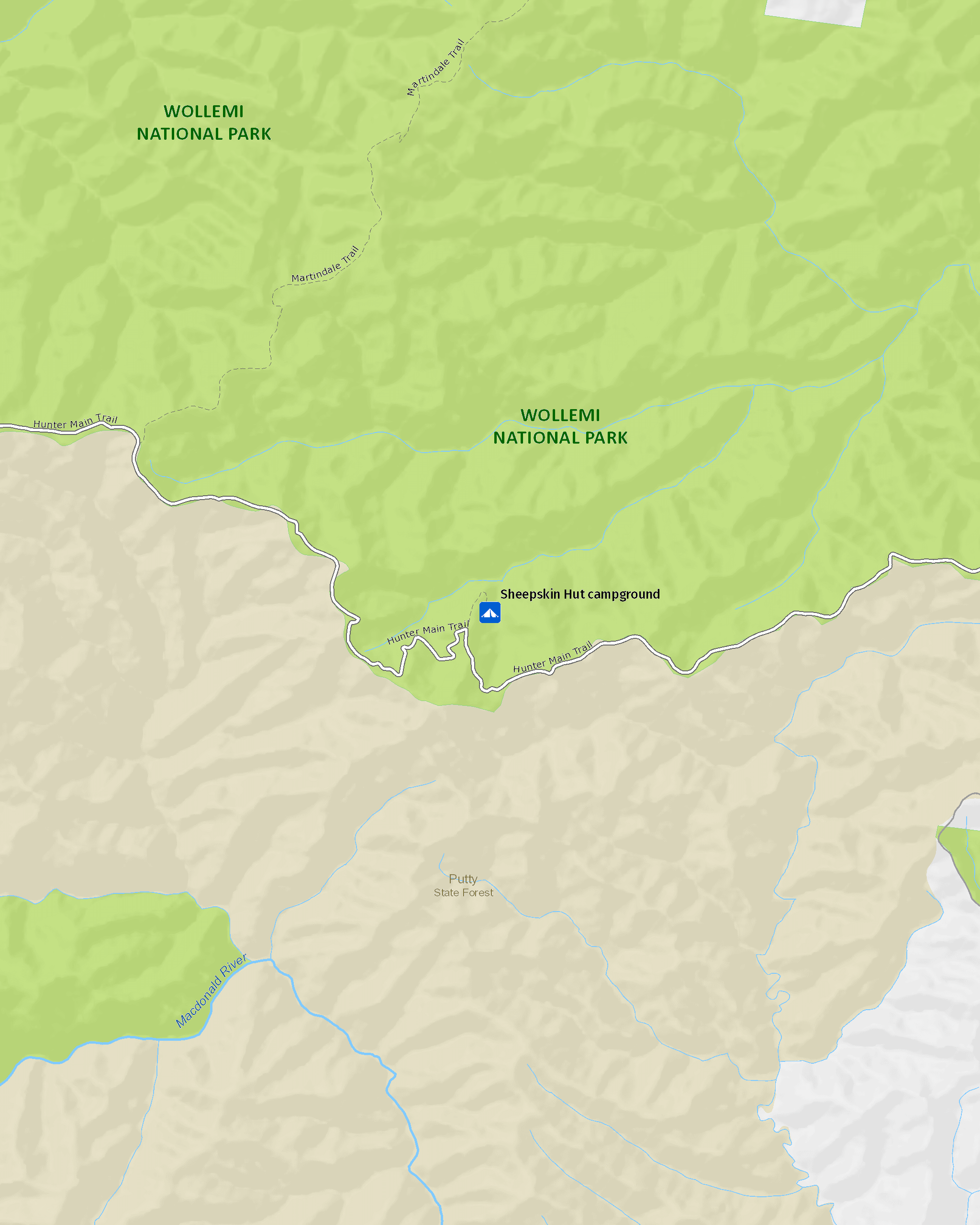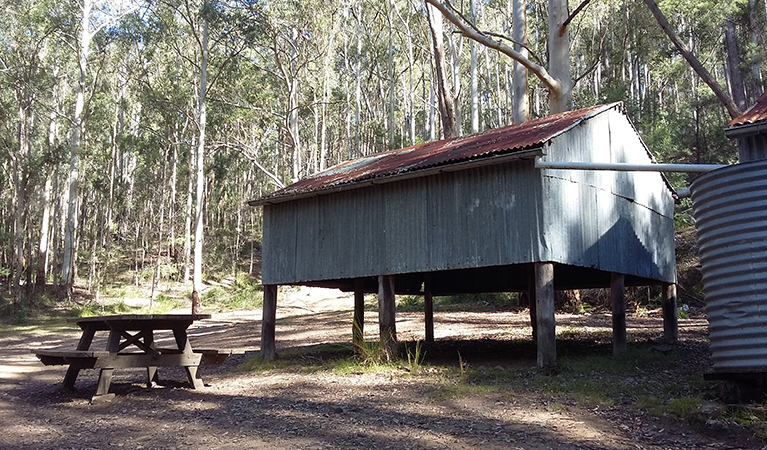Sheepskin Hut campground
Wollemi National Park
Overview
Remote Sheepskin Hut campground is deep in the picturesque Putty Valley, in northern Wollemi National Park. It’s a scenic spot for 4WD and motorbike adventurers exploring the Greater Blue Mountains Area World Heritage Property.
| Camping type | Tent, Camping beside my vehicle |
|---|---|
| Facilities | Toilets, unpowered sites, picnic tables, barbecue facilities, carpark |
| What to bring | Drinking water, cooking water |
| Price | There are no camping fees at this campground but a $6 booking fee applies. |
| Bookings | Book up to 18 people or 3 sites online. |
| Group bookings | This campground is not suitable for group bookings. |
| Please note |
|
Deep in the Wollemi wilderness is a peaceful valley where you can spend your days hiking, mountain biking and 4WDing. The remote location and rough dirt trails, off Putty Road, make this campground a favourite getaway for 4WD and motorcycle clubs.
Getting there is part of the adventure, with trails offering spectacular views. To the west look for Mount Monundilla, to the east Wareng (Little Yengo) and the dormant volcanic peak of Mount Yengo, which has Aboriginal cultural significance.
The campground is named after Sheepskin Hut and Tack Shed, first built in the late 1800s by drovers who grazed cattle in the area, then rebuilt in the 1920s.
Pitch your tent in the grassy area next to the hut. There’s also an area suitable for larger groups around 200m away. The campground is surrounded by thick eucalypt forest of mountain blue gum and rough barked apple that slopes towards Doyle’s Creek.
The area is brimming with wildlife, from kangaroos that bound through the bushland to gang-gang and glossy black cockatoos that you’ll hear screeching in the treetops above.
Map

Map legend

Local alerts
For the latest updates on fires, closures and other alerts in this area, see https://www.nationalparks.nsw.gov.au/camping-and-accommodation/campgrounds/sheepskin-hut-campground/local-alerts
Bookings
- National Parks Contact Centre
- 7am to 7pm daily
- 1300 072 757 (13000 PARKS) for the cost of a local call within Australia excluding mobiles
- parks.info@environment.nsw.gov.au
Operated by
- Bulga office
- Monday to Friday, 9.30am to 4pm.
- 02 6574 5555
- npws.wollemiyengo@environment.nsw.gov.au
- 2156 Putty Road, Bulga NSW 2330
Park info
- in Wollemi National Park in the Sydney and surrounds, North Coast and Country NSW regions
Wollemi National Park is always open but may have to close at times due to poor weather or fire danger.
Visitor info
All the practical information you need to know about Sheepskin Hut campground.
Maps and downloads
Learn more
Sheepskin Hut campground is in Wollemi National Park. Here are just some of the reasons why this park is special:
Ancient connections

The area that is now Wollemi National Park has held significance to Aboriginal people for at least 12,000 years. Evidence of this connection can be seen throughout the park, including ceremonial grounds, stone arrangements, grinding grooves, scarred trees and rock engravings. There are around 120 known Aboriginal sites in the park and probably many more yet to be discovered. The Wiradjuri, Dharug, Wanaruah and Darkinjung people have a strong and ongoing cultural association with their traditional lands and waters.
- Ganguddy-Dunns Swamp guided Aboriginal cultural tour Join Wirimbili Cultural Experience on a guided walk through Ganguddy-Dunns Swamp. Learn about local Aboriginal culture and tradition as you explore Wollemi National Park, near Rylstone.
- Guided kayak tours of Ganguddy-Dunns Swamp Experience the natural beauty of escarpments, gorges and wildlife on a guided paddling tour of Gunguddy-Dunns Swamp with Southern Cross Kayaking.
- Pagoda Lookout walking track Pagoda Lookout walking track is a short but steep walk near Rylstone in Wollemi National Park. Enjoy incredible views over ancient pagoda rock formations and the Cudgegong River.
Geological marvels

Wollemi's landscape has been sculpted over millennia into a magnificent network of soaring sandstone escarpments, plunging gorges and canyons, winding river valleys and awe-inspiring geological and geomorphological features such as pagoda rock formations, basalt-capped mountains and diatremes. The spectacular Colo gorge and its tributaries form the most extensive sandstone canyon system in eastern Australia. Grab your camera and discover for yourself the breathtaking vistas and natural marvels that make this a World Heritage treasure.
- Explore Wollemi's wonders guided tour Experience the highlights of Wollemi National Park on this guided tour with Hikeandseek NSW. Traverse canyons, tunnels and valleys while learning about the area’s history.
- Glow Worm Tunnel self-guided audio tour Discover the fascinating history of the Glow Worm Tunnel on this self-guided audio tour in Wollemi National Park. You’ll follow the bed of the old Wolgan Valley Railway line to Tunnel No. 2, now home to thousands of glow worms.
- Guided kayak tours of Ganguddy-Dunns Swamp Experience the natural beauty of escarpments, gorges and wildlife on a guided paddling tour of Gunguddy-Dunns Swamp with Southern Cross Kayaking.
- Pagoda Lookout walking track Pagoda Lookout walking track is a short but steep walk near Rylstone in Wollemi National Park. Enjoy incredible views over ancient pagoda rock formations and the Cudgegong River.
- Wollemi camping and canyoning expeditions Join Roam Adventures and Training on a camping and canyoning adventure in the stunning Wollemi National Park.
Nature's haven

It's little surprise that Wollemi's spectacular landscape shelters a rich diversity of plants and animals. The rare Wollemi pine - a 'living fossil' whose closest relatives thrived some 90 million years ago was rediscovered here in 1994, and the park protects an incredible array of botanical species and communities, from open eucalypt forest and woodlands including Hawkesbury and grey box, to rainforests and perched swamps. This variety makes it an appealing habitat for eastern grey kangaroos, red-necked wallabies and the elusive brush-tailed rock wallaby, as well as the beautifully marked broad-headed snake, regent honeyeater and glossy black cockatoo. Around 55 species of butterfly have also been recorded.
- Glow Worm Tunnel self-guided audio tour Discover the fascinating history of the Glow Worm Tunnel on this self-guided audio tour in Wollemi National Park. You’ll follow the bed of the old Wolgan Valley Railway line to Tunnel No. 2, now home to thousands of glow worms.
- Glow Worm Tunnel via Wolgan Valley loop Set aside a day to hike 9km through Wollemi National Park on Glow Worm Tunnel via Wolgan Valley loop. Marvel at the historic railway tunnel, a lush rainforest gorge, and rocky pagoda outcrops, on this special walk between Newnes and Lithgow.
Outdoor adventure

Pitch a tent at one of Wollemi's great campgrounds, like the secluded Colo Meroo backpack campground, the car-accessible Coorongooba campground or the dramatically-situated, car-accessible Newnes campground. With your base set up, you're free to get out and enjoy the park's fantastic outdoor attractions, be they more relaxed pursuits such as picnicking, canoeing and swimming or something more adventurous like rock climbing, horseriding and hiking.
Plants and animals protected in this park
Animals
-

Glow worms (Arachnocampa richardsae)
Glow worms are the larval life stage of small flying insects. They live in dark, damp caves and rainforest gullies and are best-known for the starry, bioluminescent glow of their colonies.
-

Superb lyrebird (Menura novaehollandiae)
With a complex mimicking call and an elaborate courtship dance to match, the superb lyrebird is one of the most spectacular Australian animals. A bird watching must-see, the superb lyrebird can be found in rainforests and wet woodlands across eastern NSW and Victoria.
-

Bare-nosed wombat (Vombatus ursinus)
A large, squat marsupial, the Australian bare-nosed wombat is a burrowing mammal found in coastal forests and mountain ranges across NSW and Victoria. The only other remaining species of wombat in NSW, the endangered southern hairy-nosed wombat, was considered extinct until relatively recently.
-

Southern boobook (Ninox novaeseelandiae)
The southern boobook, also known as the mopoke, is the smallest and most common native owl in Australia. With a musical 'boo-book' call that echoes through forests and woodlands, the southern boobook is a great one to look out for while bird watching.
-

Satin bowerbird (Ptilonorhynchus violaceus)
With vibrant blue-violet eyes and curious antics, the satin bowerbird is a favourite for bird watching and easy to spot as it forages for food in open forest. Relatively common across eastern Australia, in NSW they’re found in coastal rainforests and adjacent woodlands and mountain ranges.
-

Spotted-tailed quoll (Dasyurus maculatus)
The spotted-tailed quoll is the largest remaining carnivorous marsupial on the Australian mainland. It’s protected as a vulnerable species in NSW.
Plants
-

Wollemi pine (Wollemia nobilis)
The Wollemi pine is one of the world’s oldest and rarest trees. Only 46 adult trees and 43 juveniles remain in the wild. Belonging to a 200 million year-old plant family, this critically endangered Australian species is considered a global treasure.
-

Smooth-barked apple (Angophora costata)
Smooth-barked apple gums, also known as Sydney red gum or rusty gum trees, are Australian native plants found along the NSW coast, and in the Sydney basin and parts of Queensland. Growing to heights of 15-30m, the russet-coloured angophoras shed their bark in spring to reveal spectacular new salmon-coloured bark.

